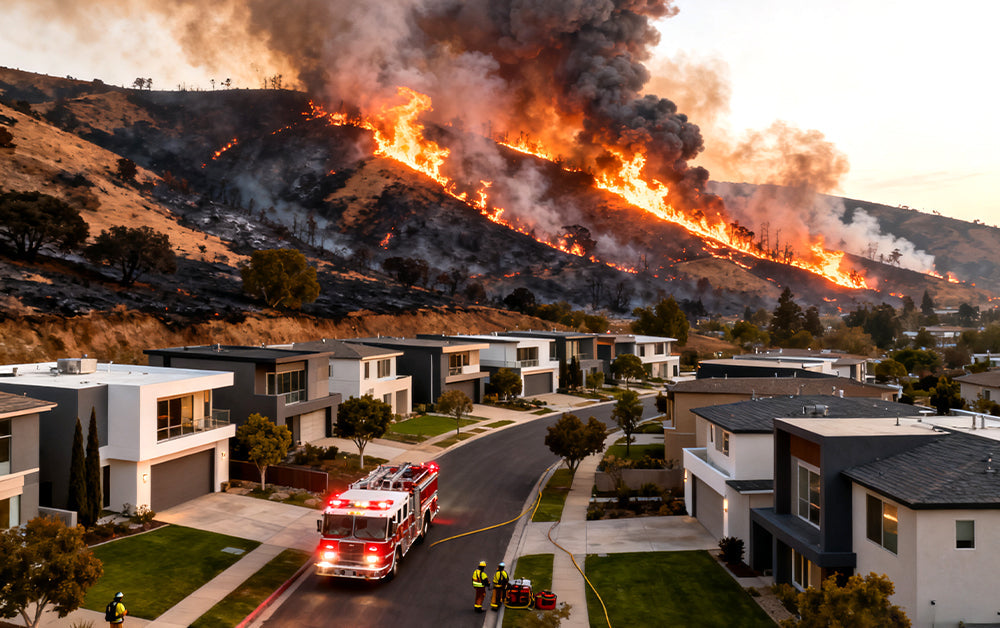Wildfire Smoke Is No Longer Confined to Forests.
Even communities far from active fires frequently experience degraded air quality as smoke drifts. According to the U.S. EPA, smoke from wildfires carries fine particles (PM₂.₅) that pose serious risks to lung and heart health. The advice from experts is increasingly clear: indoor air must be part of the defense strategy.
When smoke enters a home, ordinary fire alarms may not respond until visible haze or heavier smoke appears. By then, occupants may have already breathed unhealthy air. That’s why upgrading your smoke alarm system is a key piece of household protection in smoky seasons.

Why Upgrade Your Smoke Alarm System
Before giving you steps, here are a few things to know:
1. Photoelectric sensors are better suited to detect smoldering smoke and smoky haze than ionization-only alarms.
2. Interconnected alarms ensure that when one sensor detects danger, all alarms in the home sound together — increasing the chance everyone hears the warning.
3. Smoke alarms should be placed inside and outside every bedroom, and on every home level (ceiling or high wall).
With those in mind, here are three practical steps to make your smoke alarm system better for wildfire smoke scenarios.

3 Easy Steps to Improve Your Smoke Alarm System
1. Upgrade to smarter detection technology
Install alarms that respond more reliably to smoky particles and haze (not just thick smoke). Use units that minimize nuisance alarms (for example, from cooking steam or mild dust) while remaining sensitive enough to detect subtle changes in air quality.
Choose photoelectric or dual-sensor alarms, which tend to perform better under smoky, low-flame conditions.
2. Interconnect all alarms & optimize layout
When alarms are interconnected, a trigger in one room causes all alarms to warn simultaneously — giving more time to respond.
Ensure proper coverage:
A. Install alarms inside and outside each bedroom
B. Place at least one on every level of the home
C. Mount them on ceilings or high walls, following manufacturer guidance
D. Avoid placing alarms too close to kitchens or bathrooms where steam may cause false alerts (unless the alarm is designed to resist nuisance triggers)
3. Maintain & test regularly
An upgraded alarm system is only effective if kept in working order.
A. Test alarms monthly using the test button
B. Replace batteries or units as per recommended lifespan (often 10 years)
C. Avoid disabling alarms due to repeated false alerts — if false alarms happen often, it may indicate placement or sensitivity issues
D. Keep the area around alarms clean and dust-free
By combining better detectors, full home coverage, and consistent maintenance, you’ll drastically increase your chances of receiving early warnings when smoke infiltrates.
Bonus Measures
While a strong smoke alarm system is central, consider combining these steps to further protect indoor air:
A. Keep windows and doors closed during smoky periods to reduce infiltration.
B. Use a portable air cleaner with a HEPA filter in common rooms to reduce fine particles.
C. Avoid indoor sources of smoke or fumes: no burning candles, gas stoves, or vacuuming during heavy smoke.
These actions do not replace detecting smoke — they work alongside your alarm upgrades for a more robust safeguard.

Take the Next Step
Wildfire smoke may seep into your home even when flames are miles away. Don’t wait for visible haze to make you take notice.
1. Choose smoke alarms with better smoke sensitivity and fewer false alerts
2. Interconnect alarms and place them in every bedroom and on every level
3. Test regularly and maintain your system
With these upgrades, your home’s first defense against invisible smoke becomes more capable — giving your family precious time to act, breathe easier, and stay safer. If you need to replace or upgrade your smoke detector, please check out Siterwell link below : https://store.siterwellhome.com/



